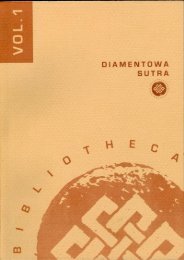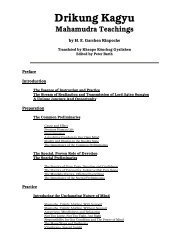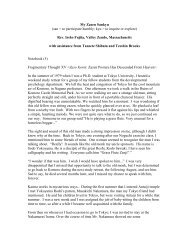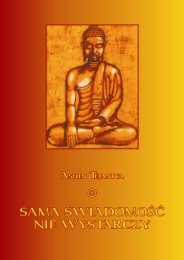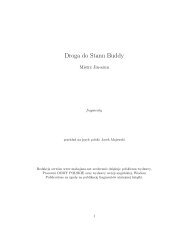3 - Computing in the Humanities and Social Sciences
3 - Computing in the Humanities and Social Sciences
3 - Computing in the Humanities and Social Sciences
Create successful ePaper yourself
Turn your PDF publications into a flip-book with our unique Google optimized e-Paper software.
Buddha (Ujike 1984: 106). Later, <strong>the</strong> term dhåra√∆ was extended to signify tools <strong>and</strong><br />
methods that were used to enable or facilitate <strong>the</strong> master<strong>in</strong>g of <strong>the</strong> Dharma. It is at this<br />
po<strong>in</strong>t that dhåra√∆ came to refer to formulae <strong>and</strong> l<strong>in</strong>guistic expressions used with<br />
mnemonic purposes.<br />
Dhåra√∆ are not only tools for acquir<strong>in</strong>g wisdom <strong>and</strong> purify<strong>in</strong>g <strong>the</strong> m<strong>in</strong>d; <strong>the</strong>y also<br />
allow for <strong>the</strong> acquisition of supernatural powers (j<strong>in</strong>z¥) as a side effect of samådhi<br />
meditation. These powers can be employed to atta<strong>in</strong> worldly benefits (genze riyaku), <strong>and</strong><br />
dharanic expressions used to this end were called “div<strong>in</strong>e spells” (Jp. sh<strong>in</strong>ju). This seems<br />
to be a belief <strong>and</strong> practice common throughout Mahayana. Ujike writes that <strong>the</strong> status of<br />
“div<strong>in</strong>e spells” did not change even with <strong>the</strong> development of <strong>the</strong> early forms of esoteric<br />
Buddhism (known <strong>in</strong> Sh<strong>in</strong>gon scholasticism as zømitsu, “miscellaneous esoteric<br />
teach<strong>in</strong>gs”). In fact, zømitsu texts, constituted mostly by formulae, might be a<br />
development of <strong>the</strong> “Dhåra√∆ chapters” conta<strong>in</strong>ed <strong>in</strong> many Mahayana scriptures (Ujike<br />
1984: 21). If this is <strong>the</strong> case, <strong>the</strong> rise of esoteric Buddhism would testify to an <strong>in</strong>creased<br />
importance of magical l<strong>in</strong>guistic formulae <strong>in</strong> Buddhism. Essentially, dhåra√∆ <strong>in</strong> both<br />
Mahayana <strong>and</strong> early esoteric Buddhism serve to facilitate <strong>the</strong> master<strong>in</strong>g of <strong>the</strong> Buddhist<br />
teach<strong>in</strong>gs <strong>and</strong> to secure material benefits. As tools of <strong>the</strong> <strong>in</strong>cessant bodhisattva practices,<br />
<strong>the</strong>y operate on <strong>the</strong> causal level (<strong>in</strong>’i) but are not directly related to <strong>the</strong> atta<strong>in</strong>ment of<br />
enlightenment <strong>and</strong> liberation, which is, accord<strong>in</strong>g to Mahayana, <strong>the</strong> f<strong>in</strong>al result of an<br />
<strong>in</strong>f<strong>in</strong>ite ascetic process. (Ujike 1984: 21).<br />
Significantly, Ujike argues that <strong>the</strong> development of esoteric Buddhism from<br />
Mahayana through an earlier, miscellaneous form (zømitsu), can be better understood<br />
through <strong>the</strong> study of <strong>the</strong> development of conceptions concern<strong>in</strong>g esoteric l<strong>in</strong>guistic<br />
expressions (Ujike 1984: 31), as represented by <strong>the</strong> transformation of dhåra√∆ <strong>in</strong>to<br />
mantras/sh<strong>in</strong>gon. In this process, perhaps <strong>the</strong> most important step was <strong>the</strong> qualitative<br />
transformation of dhåra√∆. From a faculty of <strong>the</strong> bodhisattva first, <strong>and</strong> a tool to atta<strong>in</strong> it<br />
later, dhåra√∆ subsequently turned <strong>in</strong>to a goal <strong>in</strong> itself (Ujike 1984: 47). This<br />
transformation occurred thanks to <strong>the</strong> mediation of so-called mitsugo, words that were<br />
endowed with secret, <strong>in</strong>itiatory mean<strong>in</strong>gs.<br />
Beg<strong>in</strong>n<strong>in</strong>g with <strong>the</strong> Shugokyø, dhåra√∆ as a faculty was equated with <strong>the</strong><br />
expressions on which that faculty was grounded (Ujike 1984: 117-129); at that po<strong>in</strong>t,<br />
mantric formulae <strong>in</strong> general came to be considered as <strong>the</strong> wisdom of <strong>the</strong> buddhas.<br />
Mature esoteric Buddhism (junmitsu) presents itself also as a new episteme that<br />
systematizes non-ord<strong>in</strong>ary l<strong>in</strong>guistic expressions <strong>and</strong> encompasses <strong>the</strong>m with<strong>in</strong> its<br />
teach<strong>in</strong>gs <strong>and</strong> practices. A wide range of non-systematic spells (ju) <strong>and</strong> dhåra√∆ thus<br />
10



![Shushogi, Dogen Zenji [PDF] - Mahajana.net](https://img.yumpu.com/50921105/1/190x219/shushogi-dogen-zenji-pdf-mahajananet.jpg?quality=85)


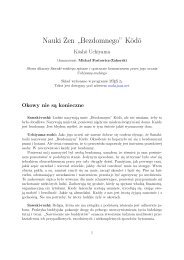

![wywiadu z Murakami Kosho Roshim [PDF] - Buddyzm w Polsce i na ...](https://img.yumpu.com/45809746/1/184x260/wywiadu-z-murakami-kosho-roshim-pdf-buddyzm-w-polsce-i-na-.jpg?quality=85)
